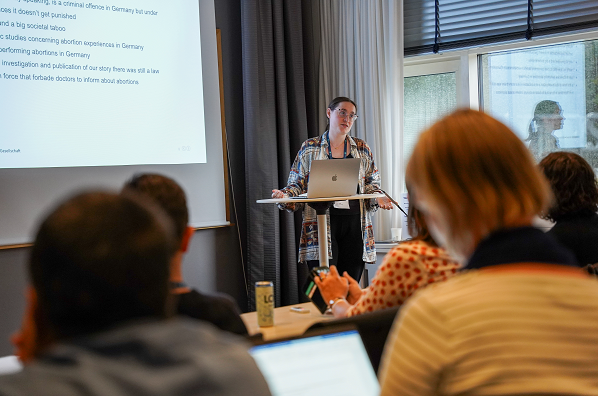

CORRECTIV investigative reporter Miriam Lenz shared starter tips with investigative journalists interested in using surveys in their reporting. Image: Edvin Lundqvist for GIJN
Tips for Using Online Surveys to Spice Up Your Investigations
A well-designed, properly distributed survey can build a powerful dataset for an investigation. But getting responses from the right audience — and of the right quality and quantity — requires time, attention to structure, and in some cases, promotional campaigns.
In 2021, the nonprofit investigative reporting group CORRECTIV.Lokal ran an investigation on abortion access in Germany, where the procedure is heavily restricted. The team looked at the impact of restricted access to abortion on the health and well-being of people who are pregnant in Germany, including how this system affects the quality of medical care.
Central to the investigation was a survey aimed at gathering the experiences of women, as well as transgender and non-binary people, who have had abortions or been part of the abortion counseling and consultation process, which is required to receive an abortion in Germany.
Using CORRECTIV’s open source Crowdnewsroom survey platform, the team received around 1,500 responses. The answers allowed the newsroom to spot regional and abortion care trends and identify case studies for further investigation.
Surveys can help you reach a lot of people to hear their experiences on an issue. They can allow people to respond on a sensitive topic anonymously and supply data on a subject where there is little to none available. Running a workshop at the 13th Global Investigative Journalism Conference (#GIJC23), CORRECTIV.Lokal journalist Miriam Lenz shared these starter tips for using surveys to power investigations.
- Before you start: You need a clear reason for using a survey, a clear research question, and to define a target audience. Without a clear research question that you want to answer, you’re in danger of missing the target audience or the answers that will be most helpful to the investigation.
- When to avoid surveys: If speaking with a few individuals would answer your research question, you don’t need a survey, said Lenz. Equally, if you don’t have the time to properly develop the survey structure or to thoroughly analyze the results, a survey is not the best approach.
- Do your research: Do some background investigation to identify possible questions or possible problems you want to interrogate in the survey. Speak to experts: Lenz and her team spoke with abortion counselors, reproductive rights activists, and others in the field to understand the potential difficulties a person seeking an abortion in Germany could face — all before writing the survey. Past reporting on the subject may also yield data or ideas.
- Qualitative vs. quantitative: Is your survey targeted at experiences (qualitative) or numbers (quantitative)? “How hard it was to find an abortion or how far did someone have to travel to get an abortion? It’s totally different,” noted Lenz.
- Careful language choices: Make sure your questions can be easily understood by participants — avoid double negatives or leading questions. Additionally, think about the terminology relating to the topic of your investigation. Abortion in Germany is a taboo subject; sharing experiences is personal and potentially stigmatizing. There are two words in German that can mean abortion — one is also used by anti-abortion campaigners; CORRECTIV used the other, albeit longer, term in its survey to be sensitive to its target audience.
- From easy to hard: Order your questions, starting with easier questions first and build up to more difficult or sensitive ones, just as you would in an interview. For qualitative surveys ask an open question at the end and decide whether participants can leave contact details — especially useful for follow-ups and case studies.

The GIJC23 workshop on using surveys in investigations, where CORRECTIV journalist Miriam Lenz explained how this tool can help journalists reach a lot of people, and supply data on a subject where there is none. Image: Edvin Lundqvist for GIJN
- Barriers to completion: How many questions will your target audience be willing to answer? Too many could put them off. If your intended survey participants speak different languages, you’ll need to translate; or if they have low or restricted internet access you may need to advertise the survey in places with public computers and internet, such as libraries or community centers. Think of the barriers to participation for your particular audience and avoid them as best you can.
- Be transparent: Make it clear in the survey introduction what you’re investigating and what you will do with the information shared. Also consider a disclaimer when publishing that the survey is not equivalent to a representative study.
- Test, test, test: If you can, test your survey on relevant experts, on members of your target group, and on colleagues outside of the investigation, to make sure it’s comprehensible and asking the right questions. Test the survey tools you’re using too.
- Stick to a timeline: Choose a start and end date for your survey before you launch it. Factor in how much time you will need to analyze the data and the overall timeline of the investigation.
- Targeted distribution: Reaching your intended audience could make or break your investigation, so think about how you can get the survey to them. CORRECTIV.Lokal partners with local media, which helped it reach all regions of Germany. It also wrote an article for the news site of an email provider to reach audiences with no prior knowledge of CORRECTIV. Lenz recommended running campaigns on social media, advertising the survey on important landing pages and embedded in relevant articles on your newsroom’s website, as well as promoting it in newsletters, flyers, and at events. Campaigners and influencers in the same field can help share it too. You need time to prepare the campaign in advance, she added — schedule several waves to sustain bigger surveys over time and keep responses coming in.
- Doing the analysis: Read every response as a team and look for themes and protagonists for case studies. Return to the results and start labeling responses by theme — this could be regional trends, patterns of experience, or other demographic details. “Your work as a journalist doesn’t end with a survey,” said Lenz. It’s a starting point for investigative work.”








